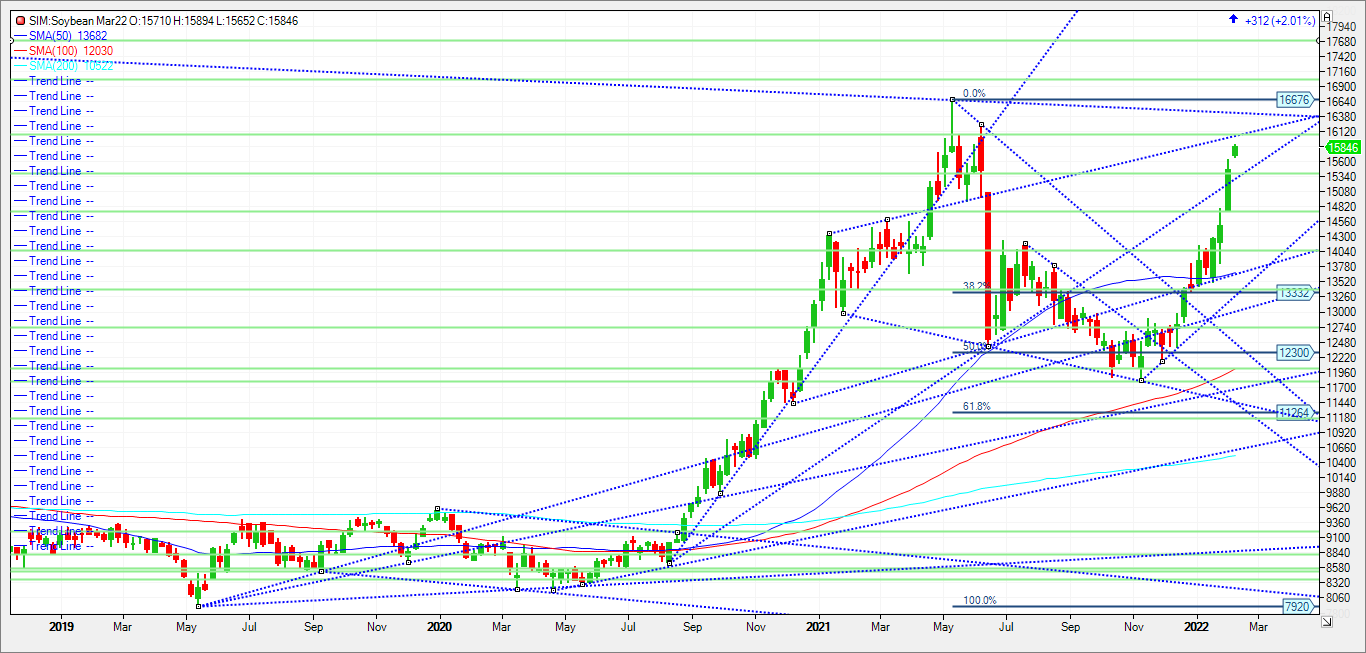Commentary
Both soybean and soymeal futures rallied to contract highs on fresh export business and expectations of adverse weather that could potentially shrink South American production. This morning, USDA announced daily soybean sales totaling 507,000 MT to “unknown destinations,” with 249,000 MT for 2021-22 and 258,000 MT for 2022-23. Unknown is spelled CHINA. Since Jan. 28, USDA has reported a combined 1.96 MMT of soybean sales to China or unknown destinations. Also today, USDA reported 1.218 MMT of soybeans inspected for export during the week ended Feb. 3, down from 1.416 MMT the previous week. In its Feb. 9 report, USDA is expected to lower its projection for Brazilian soybean production to 133.65 MMT from 139 MMT, based on a Reuters. Argentina’s crop estimate is expected to be cut to 44.51 MMT from 46.5 MMT. The average trade guess for US ending stocks is 310 million bushels down from over 350 million in the January report. PER CFTC data released on Friday February 4th, large speculators increased their bullish bets in the soybean market in late January to the highest level since May. The managed money net long in soybean futures and options jumped 39,593 contracts to 172,822 contracts for the week ended Feb. 1, the highest since the week ended May 11, 2021.
Given the WASDE report on Wednesday at 11 am central time, the trade in my view wants to ensure no surprises with a return to trading weather and demand as the main inputs for price discovery post report. Given that old crop beans have rallied over $4.00 per bushel from the November lows, some of the weather issues have become priced in my view. That said, there are still some major unknowns regarding South American Production. Dryer forecast runs in S.A. limit any sizable selling, while demand continues to feed the Bulls. I do not know how aggressive USDA will be in lowering production estimates for Brazil, Paraguay, Uruguay, and Argentina in Wednesday’s WASDE report. Brazil’s crop is pretty much made. The combines have not yet moved into the Southern part of the country to possibly confirm losses in drought stricken areas. Paraguay which exports half of its bean crop to Argentina to be crushed, could see losses up to 50 percent. Argentina, by the way is about to enter key yield development time for their bean crop where it is equivalent to the US bean crop entering into August. Some analysts and crop scouts are suggesting a South American bean crop loss of 30 million metric tons or just over 1 billion bushels. Last year the US alone grew approximately 4.4 billion bushels. It’s a sizable loss and a reason why beans are trading a $15 handle for now in my view. Technical levels for this week come in as follows. Resistance levels first at 16.00 and then 16.07, which represents 20 percent higher for the year. A close over 16.07 and we could see 16.39 and then a test of last year’s high at 16.67. Support is first at last nights gap at 15.65 and below there at 15.40 . A close under 15.40 may push the market down to 15.30, and with a close below that level the next target would be the 10 percent threshold at 14.77 in my opinion.
Trade Ideas
Futures-N/A
Options-N/A
Risk/Reward
Futures-N/A
Options-N/A
Please join me for a free grain and livestock webinar every Thursday at 3pm Central. We discuss supply, demand, weather, and the charts. Sign Up Now

Walsh Trading, Inc. is registered as a Guaranteed Introducing Broker with the Commodity Futures Trading Commission and an NFA Member.
Futures and options trading involves substantial risk and is not suitable for all investors. Therefore, individuals should carefully consider their financial condition in deciding whether to trade. Option traders should be aware that the exercise of a long option will result in a futures position. The valuation of futures and options may fluctuate, and as a result, clients may lose more than their original investment. The information contained on this site is the opinion of the writer or was obtained from sources cited within the commentary. The impact on market prices due to seasonal or market cycles and current news events may already be reflected in market prices. PAST PERFORMANCE IS NOT NECESSARILY INDICATIVE OF FUTURE RESULTS.
All information, communications, publications, and reports, including this specific material, used and distributed by Walsh Trading, Inc. (“WTI”) shall not be construed as a solicitation for entering into a derivatives transaction. WTI does not distribute research reports, employ research analysts, or maintain a research department as defined in CFTC Regulation 1.71.
Sean Lusk
Vice President Commercial Hedging Division
Walsh Trading
312 957 8103
888 391 7894 toll free
312 256 0109 fax
Walsh Trading
53 W Jackson Suite 750
Chicago, Il 60604
